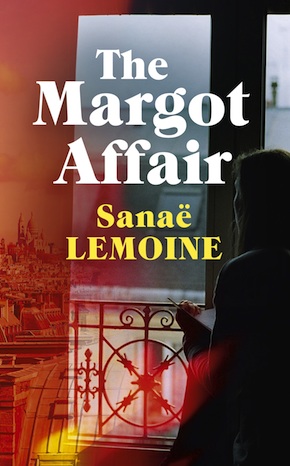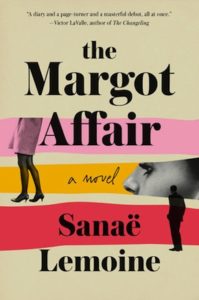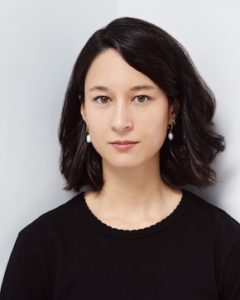Sanaë Lemoine: Brittle love
by Mark Reynolds
“Illuminates the ways in which violence and care are strung through generations like nerves and sinews.” Jessica Andrews
Sanaë Lemoine’s debut novel The Margot Affair is narrated by the illegitimate teenage daughter of leading French actress Anouk Louve and prominent politician Bertrand Lapierre. Margot has grown up under a shroud of silence and shame, and as she emerges into adulthood she treads an independent path that threatens to stretch the bonds of family to breaking point. By confiding in journalist couple David and Brigitte Perrin about her father’s identity, she cracks open a Pandora’s box of secrets that will have unwelcome repercussions. Ten years in the writing, it is an assured and provocative examination of heightened emotions, complex love and unintentional betrayal.
MR: Margot is encouraged by Brigitte to write about her relationship with her father while she is still young and her feelings are fresh. How readily were you able to reconnect with your 17-year-old self to recreate the outlook of a worldly-wise but vulnerable teenager?
SL: On the one hand it was exhilarating to exist in the very specific and constrained world of a 17-year-old character. I enjoyed inhabiting her voice through the intensity of her observations. There were moments in the drafting process when I drew from my own experiences of being a teenager in Paris, but Margot as a character took on such a force of her own, and my life was much less eventful than hers! Ultimately it was a feeling that I hoped to recreate for my readers – the transformative moment of being on the cusp of adulthood, testing one’s agency, being confronted with the repercussions of one’s choices, a first experience of mutual seduction.
It became challenging, however, to always stay within Margot’s point of view. After a few years it began to feel quite narrow, especially as I moved towards my late twenties. I had to find ways to stay engaged, by going deeper into her emotions for example, investigating the ripple effects of her actions, and also opening up the narrative to other characters.
To what extent did the narrator of Françoise Sagan’s Bonjour Tristesse help shape Margot’s voice?
I came across Bonjour Tristesse halfway through writing my novel, so somewhat late in the process although I’d been hearing about Sagan’s slim novel for years. When I finally picked it up, I felt that jolt of recognition. In many ways, Margot is different from Cécile, the narrator of Bonjour Tristesse, but I immediately sensed a kinship in their way of seeing the world, that combination of sharp wisdom and tender naïveté. That said, I’m not sure I realized how much Sagan’s novel had imprinted on me until I found myself incorporating it into a conversation between Margot and Brigitte. And then, over time, it became a point of reference for the characters.
What stayed with me wasn’t the public scandal of a French president hiding an illegitimate daughter. It was the intimacy of their relationship, the small domestic details, a relationship nurtured behind closed doors.”
There are strong echoes of President Mitterrand’s secret daughter Mazarine Pingeot, who went on to publish the diary Bouche cousue (Not a Word) about her ‘hidden childhood’. In what ways were her book – and the way her existence was exposed back in 1994 – a touchstone for your novel?
I’d known about Mitterrand and Mazarine for as long as I can remember, but when I began writing my novel, I was more inspired by events in my own life. My father kept a second family hidden from me and my mother for several years. The same summer I learned about his other family I was working as a researcher for a journalist in Paris. One of my assignments was to read Mazarine’s Bouche cousue. I remember that what stayed with me wasn’t the public scandal of a French president hiding an illegitimate daughter. It was the intimacy of their father-daughter relationship, the small domestic details, a relationship nurtured behind closed doors. Perhaps this subconsciously propelled me to write a novel that focused on the private reverberations of an affair, rather than the public fallout. How would Margot be shaped by a life of secrecy? How does one grieve a parent who is more absent than present? In what ways is Margot’s relationship with her mother transformed by the reveal?
The whole novel reads like a love letter to Paris and its contrasting neighbourhoods. Which parts of Paris feel most like home to you, and was it easier or trickier to describe Paris from afar?
When I first began writing the novel, I didn’t think about Paris as a setting, it was simply the most familiar place. I was so focused on the characters and their relationships that I neglected describing the city. It was always vivid in my mind and I didn’t pause to think about how that would translate for my reader. Later, when my editor asked for more texture, I thought about how a neighbourhood would feel to Margot, what small moments and details she’d pick up on. It was important that the descriptions feel authentic to a French reader, without being alienating or elusive to someone who has never spent time there. I returned to Paris often to visit family, and during those trips I made a point of journaling, writing down my impressions even if they seemed obvious. I also thought about it in contrast to New York, which had become my home: How the winter sky in Paris is often white whereas New York has these stunning blue skies even though it can be much colder; the inner courtyards of Parisian apartment buildings; the parks I would return to over and over again. In a way it was easier to write about Paris when I was far from it – the memories felt more immediate and emotionally charged – but it was also harder in the sense that I was afraid the distance would result in a sentimentalized version of the city.
I spent my teenage years in the suburbs of Paris, so the centre of Paris was not entirely familiar to me (nor did it feel like home) until my early twenties, when my father temporarily rented an apartment close to the Jardin du Luxembourg. You’ll notice I placed Margot and her mother in a similar neighbourhood. My father isn’t from Paris and I thought about his desire to live in that neighbourhood and assimilate, even if just for a short while. It had always been a dream of his, and I absorbed this longing into my novel.
All the main characters are influenced by cinema, and Margot reflects that her father Bertrand always identified with Truffaut’s Antoine Doinel. In what ways is Doinel a positive – or negative – role model?
Margot’s father loves The 400 Blows and identifies with Antoine Doinel. He loves the easy confidence with which Doinel roams the streets of Paris. How Truffaut portrays Paris as a maternal figure – he’s starved for affection and turns to the city for nourishment, she symbolically takes him in when his parents reject him, he seeks refuge in a printing factory at night, he steals milk from her streets and drinks it. Margot’s father was raised in a small town and came to Paris to study. He sees Paris as a place of freedom, where his hard work has been rewarded with a successful career in politics, and he admires Doinel’s energy, resourcefulness and independence.
Anouk is introduced in the opening pages as having made her name as an actor in a stage play as a mother who kills her children, but conceals her capabilities beneath a veneer of levity and tenderness. Is Mère an actual play or your own invention? And what should we read into Anouk’s success in that role?
Mère was my own invention. Anouk plays a woman who murders her three children in a bathtub. I wanted the reader to be alerted to Anouk’s sharp edges, and how Margot has always seen her mother through this lens of suspicion and potential for violence. Margot was too young to see Mère, but the role has defined her mother’s career and is often referenced in conversation. How can Margot not feel a bit uneasy around her?
So much of the novel is about Margot understanding the shape of her mother’s unconditional love. She’s also aching for a father who never prioritized her, who was possibly ashamed of her existence.”
You brilliantly capture the unconditional love and casual cruelty that can exist between a mother and daughter as they circle each other and affirm their individuality and identity. Was it unreasonable for Margot to ask repeatedly while growing up if Anouk would sacrifice herself to save her?
Anouk has always wanted to draw a clear distinction between parent and child while Margot yearns for a mother who will hold her, act as a confidant. Margot’s question – will you sacrifice your life for me? – comes from a place of uncertainty. So much of the novel is about Margot understanding the shape of her mother’s unconditional love. She’s also aching for a father who never prioritized her, who was possibly ashamed of her existence. Those insecurities flare up in moments when she feels especially vulnerable. With this novel, I thought about how hard I was on my own mother, not seeing the ways she took care of us, and how easy I was on my father. I held my mother to a higher standard, expecting that she be everything I needed. And so, I sought to explore this tension in Margot’s relationship with Anouk in a heightened way.
Anouk is also a dancer, and played Antigone, which despite her red curls put me in mind of Juliette Binoche. Did you fantasise about who might play Anouk and Margot in a film version of the book during the writing of it?
I love this kind of question. If it’s a French cast, I’m imagining a young Léa Seydoux for Margot. I loved her in La Belle Personne. And yes, Juliette Binoche for Anouk. That would be the dream! I often thought about her stunning performance in Three Colours: Blue. Or perhaps someone tall and statuesque like Tilda Swinton in A Bigger Splash. (In that case, Millie Bobby Brown as Margot!)
Food is lovingly described throughout the book, and I was pleased to find the recipe for Brigitte’s caramelised pear clafoutis on your website. How great is your own passion for food – and what are your tips for making the perfect clafoutis?
Oh, my passion for food is boundless. I come from a family of cooks – both my parents love to cook and eat, especially my mother who prepares mostly Japanese-inspired food. I spent countless hours in the kitchen watching her cook. When she read my novel, she was horrified to learn that Margot’s mother doesn’t know how to cook.
What I like most about a clafoutis is that it’s incredibly easy and forgiving. My recipe calls for heavy cream and whole milk, but you could use just milk and any kind of fruit. In the summer I’ll throw in blueberries. The most important thing is to bake the clafoutis until the custardy filling is set. Make sure the top is puffed and dark golden, and a sharp knife or skewer comes out clean. I also recommend storing leftovers in the fridge and warming them up in the oven, then serving with a spoonful of thick yogurt or whipped cream.

“Lemoine writes in lush, lyrical prose that perfectly captures the heightened emotion and confusion of being a young woman with a bruised heart.” New York Times
How did the MFA at Columbia University help shape this novel, and build your confidence as a writer?
The MFA was enormously helpful in the sense that it gave me my first community of writers (through friendships), the time to write (two full years!), and the mentorship of teachers, without whom there would be no Margot. There’s one class that taught me how to write a novel: a year-long workshop with Victor LaValle. We workshopped 50 to 100 pages at a time, which allowed us to wrestle with plot and character development. Several of us had been writing ‘interconnected short stories’ rather than novels with building tension and compelling character arcs. It was a difficult class and often I felt my confidence as a writer chipping away, but by the end we came out as stronger writers, more attuned to structure and narrative movement. There are several pieces of advice I often return to, especially this one: Write the simplest story.
In the acknowledgements, you thank your mother for sharing her love of storytelling and invention. How has she nurtured those qualities in you?
She’s such a storyteller. I remember her telling me stories for hours – before going to bed, in the car, at any hour of the day. She says I was insatiable, which doesn’t surprise me. As soon as I could read on my own, I spent hours reading indoors. (And she worried I wasn’t getting enough fresh air or making friends.) But even today, we’ll talk on the phone for hours, or rather I’ll listen to her telling me a wild story – something she’s lived or seen or heard somewhere, usually a bit morbid and dark. She has a terrific memory for strange details. A few of her stories inspired stories the characters tell each other in The Margot Affair.
You grew up in France and Australia and now live in New York. Do you feel rooted there, or might you be on the move again anytime soon?
I feel fairly rooted in New York, though the pandemic has shaken my sense of home. New York has felt like home to the extent that it’s where my community lives, the close friends who form my chosen family. Several of those friends have now left the city and I’m not sure when they’ll return. I know it’ll be harder to visit family in France, and that makes me anxious. I always hoped I might one day figure out a magical way to split my time between New York and Paris.
Unsurprisingly I’m drawn to stories that explore fraught mother-daughter relationships, such as Nothing Holds Back the Night by Delphine de Vigan and more recently Violaine Huisman’s writing.”
Which other books coming out of France in recent years have most impressed you, and why?
I’m embarrassed that I don’t keep up with the newest releases in France as much as I’d like to, maybe I’m too focused on books being published here. Unsurprisingly I’m drawn to stories that explore fraught mother-daughter relationships, such as Nothing Holds Back the Night by Delphine de Vigan and more recently Violaine Huisman’s writing. I devoured Virginie Despentes’ Vernon Subutex trilogy. Next on my reading list is All About Sarah by Pauline Delabroy-Allard, which I’m so looking forward to discovering.
What are you writing next?
I’m in the early stages of writing a second novel. It’s very different from The Margot Affair in scope, voice and setting. The protagonist is a Japanese woman in her mid-thirties who returns to Japan after living in Argentina for several years. She’s come home to see her sister who is embroiled in the death of a famous radio broadcaster. The novel is set in the 1980s and takes place over several years. I love inhabiting a different voice and setting after spending almost ten years with Margot.
Forsyth Harmon has made a series of watercolours inspired by Margot’s Paris. How did that collaboration come about, and why did you choose The Conscious Kid as the benefitting charity?
Forsyth and I met our very first semester at Columbia. We were in workshop together. I was quite shy at the time and Forsyth intimidated me. She had started her own business in her twenties and was a talented artist along with being a writer. I never imagined we’d become friends, and yet we did quite early on and have been reading each other’s writing for almost ten years. (Keep an eye out for her gorgeous novel Justine, coming out in March 2021.) Forsyth was familiar with Margot’s world from having read several drafts of the novel. I’m not sure who suggested the illustrated map, perhaps it organically emerged in a conversation. We had fun imagining what the different apartments might look like from the outside.
My novel was published in the US on 16 June. It’s a time of deep social and cultural change, and I didn’t feel comfortable directing attention solely to my novel. We sold Forsyth’s beautiful original watercolours for donations – it felt like a chance to celebrate her artwork and bring awareness and financial support to organizations that need it the most. We chose an organization that focuses on education through anti-racist children’s books. The Conscious Kid felt like a natural fit given our love of books and art.
 Sanaë Lemoine was born in Paris to a Japanese mother and French father, and raised in France and Australia. She earned her undergraduate degree from the University of Pennsylvania and her MFA at Columbia University and now lives in New York. The Margot Affair is published in hardback and eBook in the UK by Sceptre, and in the US by Hogarth Press.
Sanaë Lemoine was born in Paris to a Japanese mother and French father, and raised in France and Australia. She earned her undergraduate degree from the University of Pennsylvania and her MFA at Columbia University and now lives in New York. The Margot Affair is published in hardback and eBook in the UK by Sceptre, and in the US by Hogarth Press.
Read more
sanaelemoine.com
@SanaeLemoine
Author portrait © Gieves Anderson
Mark Reynolds is a freelance editor and writer, and a founding editor of Bookanista.
@bookanista
wearebookanista

